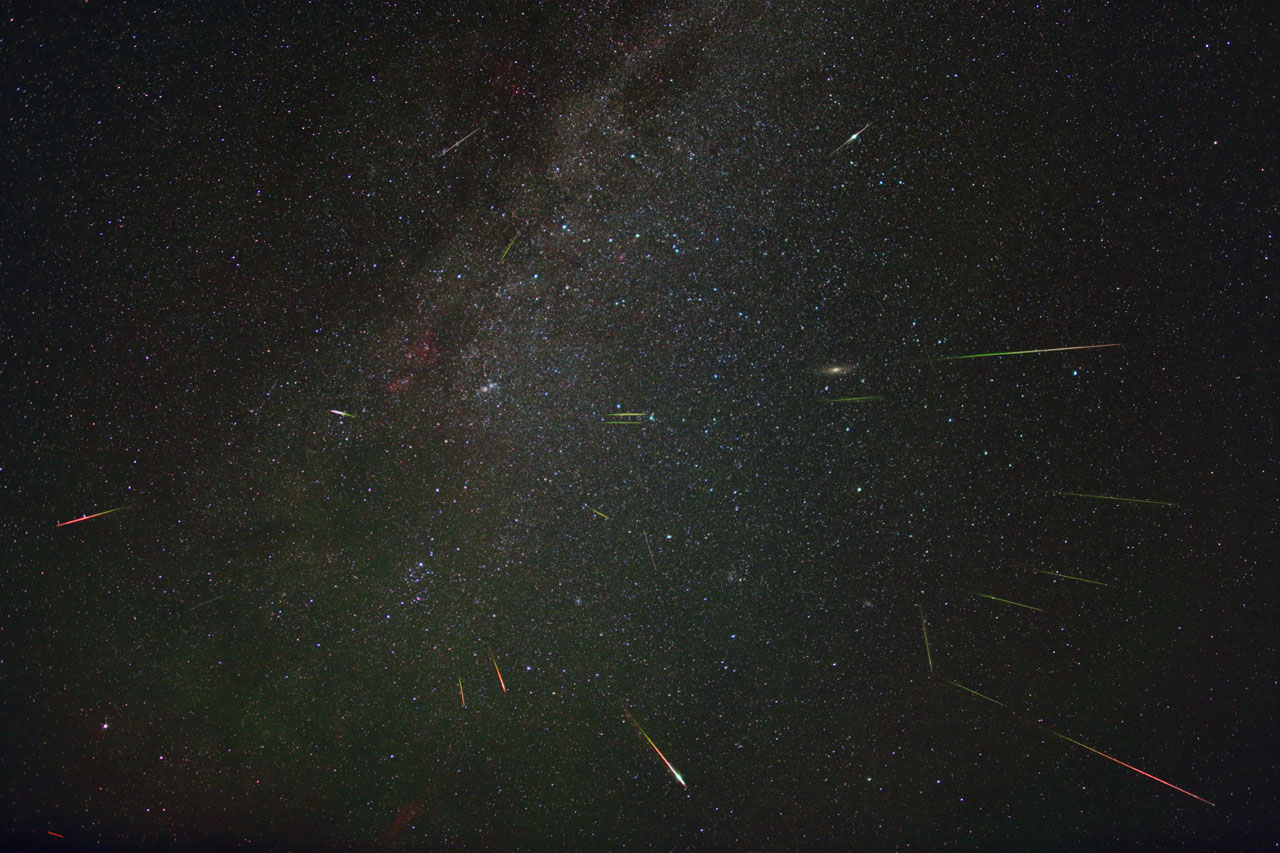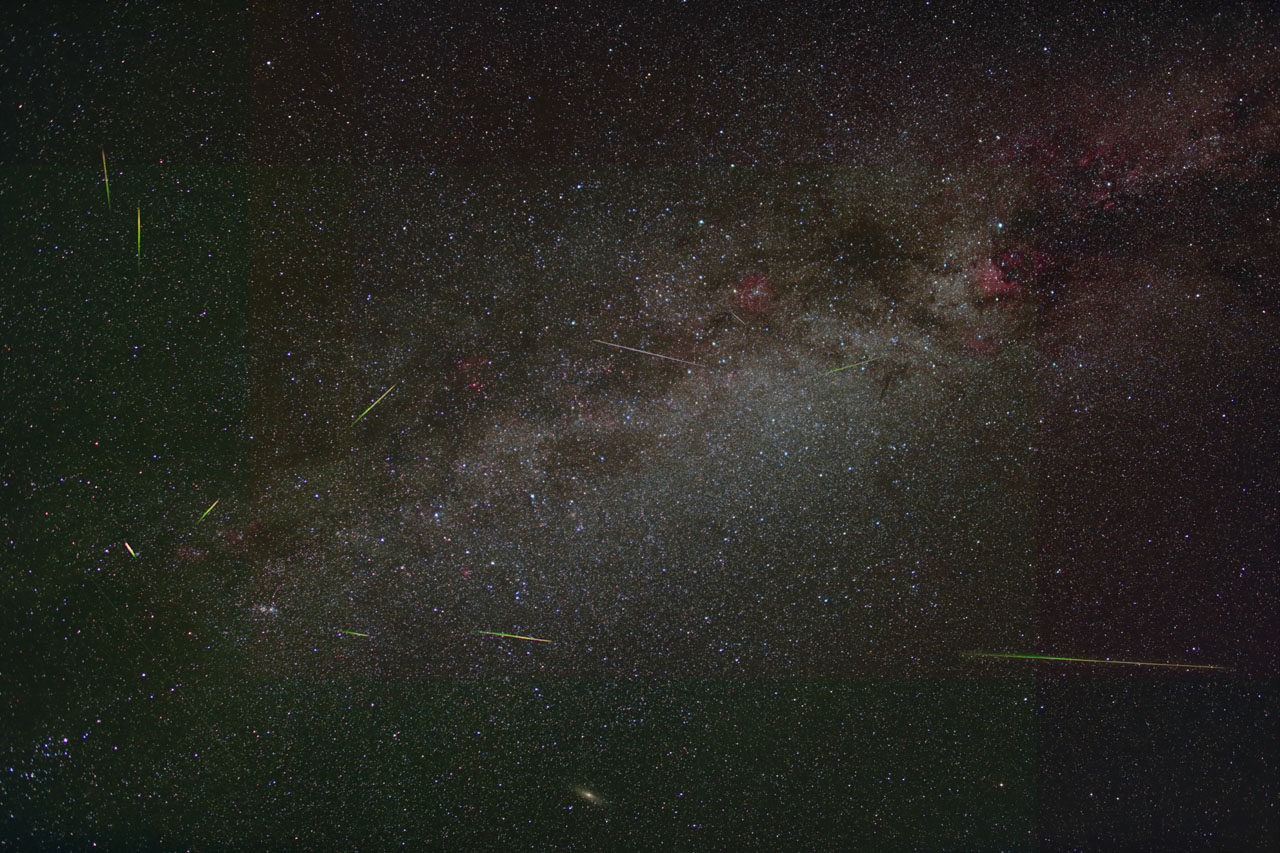The last night of the Oregon Star Party (OSP) was a day before the peak of the annual Perseid meteor shower, but close enough that we were seeing a bunch of them. And that last night was pretty much clear of the smoke that had plagued us all week, so I set up a DSLR camera with a fast, wide-angle lens on a tracking mount to capture a few of them.
The above photo is a composite of more than a dozen individual frames containing one or more meteor streaks. The camera was pointed toward the constellation Perseus, which was just a bit over the northeast horizon at the time. I captured about 400 frames over a little more than an hour (10 seconds per frame). Since the camera was on a tracking mount, the part of the sky seen stayed about the same. I then searched through the frames and selected the ones that had meteors in them. Because the mount is a simple device it does not track perfectly, and I had to manually align the stars in each frame. Then it is a simple matter of combining the images with a blending mode of “lighten” so that the meteors all appear at full brightness, while the background stays pretty much constant.
Not all the visible streaks in this image are meteors. There are also some airplanes and satellites visible. But the bright green, yellow, and red streaks are all meteors, although not necessarily Perseid meteors. You can see that most of the meteors seem to come from the same part of the sky, Perseus, and that is why they are called Perseid meteors. They are caused by the debris left behind when comet Swift-Tuttle passes by, as it last did in 1992. The comet’s path is pretty constant, and Earth passes through the same region every year at the same date, August 12th. When this debris hits Earth’s atmosphere the particles (mostly very small bits, like a grain of sand) heat up and produce a brief, bright light. Larger ones leave a trail that is visible for a short time.
There’s another bright line near the top and a little right of center in this photo. It’s the right size and brightness, and even seems to line up with Perseus, but something is not right about it: It doesn’t have any color, and there is an extra bright spot in the middle (meteors are sometimes brightest in the middle, but not extremely brighter, creating a spot right in the middle). I believe this is what’s called an Iridium flare. The Iridium satellites have very shiny flat surfaces that catch the Sun as they pass at just the right time and angle. Other satellites produce similar streaks and flashes, but the Iridiums are unusually bright and brief because of their shiny, flat surfaces.
I was getting a lot of meteors from this part of the sky, but also a lot of airplanes and satellites, so after 400 frames I moved the camera to point to a higher part of the sky:
The Andromeda galaxy is visible in both of these photos, and at least a portion of Perseus is also in both, but it’s near the lower left corner in this case. The upper right corner shows a large portion of the constellation Cygnus, including some red nebulosity, such as the North America nebula.
There are a couple of streaks near the center that might not be meteors at all. My first rule for selecting the frames that contain meteors is that a line that continues from one frame to another is not a meteor because they don’t last that long. Airplanes and satellites, on the other hand, are typically visible over multiple frames. These 2 streaks appeared in individual frames, so they last no more than 10 seconds, but the color and brightness doesn’t really look like a meteor, and they aren’t aligned with Perseus. Ultimately, I can’t be sure what they are.
I’ve attempted to capture a meteor shower before, but didn’t have the right equipment to do it properly. One key to success with this method is to resist the urge to move to a different part of the sky because you’re not seeing any meteors at the current location. You can only combine frames this way if they are all captured pointing at the same part of the sky – which also means that you need to use a tracking mount. With a fixed mount you can produce a good time-lapse video, but this also requires not moving the camera for a long time.
I got fewer meteors when pointed up higher (the 2nd photo is a composite from over 800 frames), but with a cleaner, more interesting background. I probably should have let it run all night, but I had to go to bed around 2AM so I could get up by 8 to start packing up for the long drive home. It doesn’t sound like a good reason when you consider that it might be years before we get the Perseids under a new moon.

